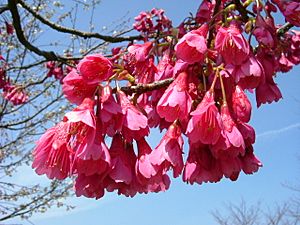Taiwan cherry facts for kids
Quick facts for kids Taiwan cherry |
|
|---|---|
 |
|
| Prunus campanulata blossoms | |
| Scientific classification | |
| Genus: |
Prunus
|
| Species: |
campanulata
|
| Synonyms | |
|
|
The Prunus campanulata is a type of cherry tree. It is also known as the Taiwan cherry, Formosan cherry, or bellflower cherry. This tree grows naturally in places like Japan, Taiwan, parts of China, and Vietnam.
It can be a large bush or a small tree, usually growing about 3 to 8 meters (10 to 26 feet) tall. People often plant it because its flowers are very beautiful. It is even a special symbol for the city of Nago in the Ryukyu Islands of Japan. A scientist named Carl Johann Maximowicz first described this plant in 1883.
Contents
Is the Taiwan Cherry an Invasive Plant?
Sometimes, the Taiwan cherry can grow too much in new places. In the Northland Region of New Zealand, it is considered an invasive plant. This means it can spread quickly and harm local plants.
Because of this, it is against the law to plant, sell, or move parts of this tree in that area. This includes soil or gravel that might have its seeds.
How Taiwan Cherry Helps Nature
The Taiwan cherry is important for some animals. It is a host plant for the caterpillars of the Chrysozephyrus nishikaze butterfly. This butterfly is special because it only lives in Taiwan.
The flowers and sweet nectar of the Taiwan cherry are also a main food source for Taiwan yuhina birds. They eat from these trees when they are raising their young.
Reproduction and Life Cycle of the Taiwan Cherry
The Taiwan cherry is one of the first cherry trees to bloom each year. Its seeds need to go through a special process to grow. They must be exposed to cold and then warm temperatures before they can sprout.
Pollinating insects help the flowers to make seeds. After planting, these trees can start to bloom and produce flowers in just 1 to 2 years.
Images for kids
-
Two tui in a flowering P. campanulata tree




